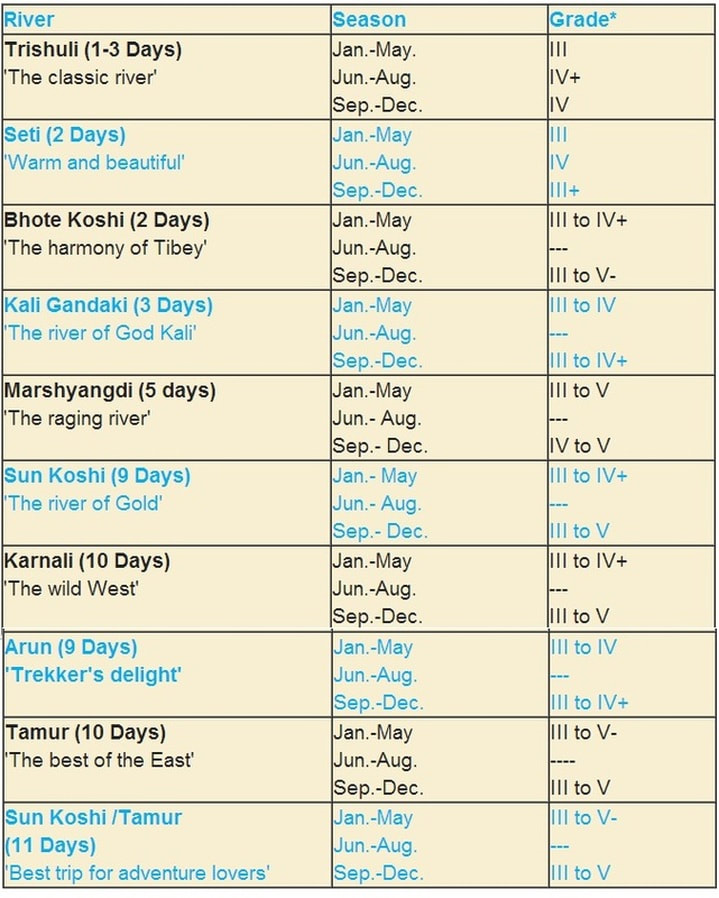
During your Nepal trip if you have some days left and Looking for some adventure trip Please do some Rafting trip in Nepal If you are travelling from Kathmandu to Pokhara , chitwan or Lumbini you can do rafting in Trishuli river and you can reach in your destination in same day which is not effect your following trip. Rafting or white water rafting is a challenging recreational outdoor activity using an inflatable raft to navigate a river or other bodies of water. This is usually done on white water or different degrees of rough water, in order to thrill and excite the raft passengers. The development of this activity as a leisure sport has become popular since the mid-1970s. It is considered an extreme sport, as it can be dangerous.
Below are the six grades of difficulty in white water rafting. They range from simple to very dangerous and potential death or serious injuries.
Very small rough areas, might require slight maneuvering.
(Skill Level: Very Basic)
Some rough water, maybe some rocks, might require some maneuvering.
(Skill level: basic paddling skill)
Whitewater, small waves, maybe a small drop, but no considerable danger. May require significant maneuvering.
(Skill level: experienced paddling skills)
Whitewater, medium waves, maybe rocks, maybe a considerable drop, sharp maneuvers may be needed.
(Skill level: whitewater experience)
Whitewater, large waves, large volume, possibility of large rocks and hazards, possibility of a large drop, requires precise maneuvering.
(Skill level: advanced whitewater experience)
Class 6 rapids are considered to be so dangerous as to be effectively unnavigable on a reliably safe basis. Rafters can expect to encounter substantial whitewater, huge waves, huge rocks and hazards, and/or substantial drops that will impart severe impacts beyond the structural capacities and impact ratings of almost all rafting equipment. Traversing a Class 6 rapid has a dramatically increased likelihood of ending in serious injury or death compared to lesser classes.
(Skill level: successful completion of a Class 6 rapid without serious injury or death is widely considered to be a matter of great luck or extreme skill)

The time of the year can really make a big difference in the flow of water in the rivers. The flow of the rivers during the monsoon in July and August are ten times are more than the flow of water in March.
It is usually best for beginners to go on a trip after mid-October, when the rivers become milder. During the November the rivers are mainly fast-moving, but not too difficult. The busiest rafting season is in October and November. The best seasons for rafting are from September to December and March to early June. In December and January many river become cold and unless you have a wetsuit they may not be enjoyable. The winter is not as cold as might be expected because most of the trips are on rivers areas below 500m elevation. The rivers are the most mild between from December to April. During the winter is a slower time for tourism, there are less options with tour operator for rafting trips.
From March to the mid-May because the river flow is low, the rivers do not move as quickly. If the water is running faster on a river at a particular time of the year, the trip can take a shorter time than if it is running slower.
From early September to early October and late-May to late-June (when snow melts in the mountains and some pre-monsoon rainfall) the rivers can flow very quickly. During this time rafting can be more dangerous than normal. It is best to raft with an experience company at this time, because extra precautions need to be taken.
During the monsoon, from June to August only experts should do rafting trips. During this time there may be 10 times as much water flowing in the rivers. Rafting can only be done on certain rivers during this time.
Various rivers can be different depending on the time of year. Depending on the time of the year you are in Nepal, can adjust what river you go on.

Nepal’s rivers can be broadly divided into three categories in accordance with their origins. The first category comprises the three main river systems of the country-the Koshi, Gandaki and Karnali river systems, all of them originating from glaciers and snow-fed lakes.
The Koshi river system consists of the Tamor, Arun, Dudhkoshi, Likhu, Tamakoshi, Sunkoshi and Indravati rivers. Of these, the Arun and Sunkoshi originate in Tibet . The confluence of these rivers is at Tribeni (near Dharan) in Sagarmatha Zone. Flowing for almost 10kms through a narrow gorge before entering the plains, the "Sapta Kosi" or he "Koshi" swollen with the waters of the seven riversÕ finally merges into the Ganges .
The Gandaki river system in central Nepal consists of the Kali Gandaki, Budhi Gandaki, Marsyanghi, Trishuli, Seti, Madi and Daraundi rivers. The Kaligandaki is the longest river and the Trishuli, the main tributary of this system.
The Kaligandaki originates in Mustang and converges with the Trishuli at Deoghat in Chitwan. The river is then called the Narayani and goes on to meet the Ganges . The Karnali river system in western Nepal consists of the Humla Karnali, Mugu Karnali, Seti and Bheri rivers and is the longest river system in the country. The Humla Karnali, which rises in Tibet , is the main tributary. After entering India , this river assumes the name Gogra .
Rivers like the Mechi, Mahakali, Bagmati, Kamala, Rapti, etc., most of which have their origin in the Mahabharat range, constitute the rivers of the second category. The Bagmati, which rises at Bagdwar and drains out through the Chobhar gorge, is the principal river of the Katmandu Valley .
Streams and rivulets originating mostly from the Chure hills make up the third category; these rivers rely on monsoon rains and are otherwise dry